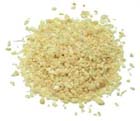|
|
Glossary Selection
Galanga | |||
| Galangal, also known as blue ginger), is a rhizome with culinary and medicinal uses, best known in the west today for its appearance in Thai cuisine (e.g., tom kha gai) but also common in recipes from medieval Europe. It resembles ginger in appearance and taste with an extra citrus aroma and a slight hint of soapiness. It is available as a powder from vendors of Oriental spices and also available in whole, cut or powdered from vendors of herbs. Also known as galingale or laos (its Indonesian name). Coincidentally, it is one of the most prominent herbs in Lao cuisine. | |||
Gambas al Ajillo | |||
| Shrimp sizzled in garlic and oil sauce with a touch of dried chili pepper. | |||
Gari | |||
 | Gari is a type of tsukemono (pickled vegetables). It is sweet, thinly sliced young ginger that has been marinated inside a solution of sugar and vinegar. Gari is often served and eaten with sushi. Although many brands of commercially produced gari are colored to promote sales, the actual pickle is naturally pink in colour. This is likely the result of chemical compounds inside the ginger reacting or denaturing due to the added vinegar, thus creating a red color. | ||
Garden eggs | |||
 | Term for a small green skinned African eggplants. | ||
Gombo | |||
| The West African word for Okra, American derivative of any stew using okra is called a gumbo | |||
Groundnuts | |||
| The peanut or groundnut (Arachis hypogaea) is a species in the pea family Fabaceae native to South America. It is an annual herbaceous plant growing to 30 to 50 cm (one to one and a half feet) tall.The leaves are alternate, pinnate with four leaflets (two opposite pairs; no terminal leaflet), each leaflet 1 to 7 cm (1/3 to 2.75 inches) long and 1 to 3 cm (1/3 to 1 inch) broad. The flowers are a typical peaflower in shape, 2 to 4 cm (3/4 to one and a half inches) across, yellow with reddish veining. After pollination, the fruit develops into a legume 3 to 7 cm (1 to 2 inches) long containing 2 to 3 (rarely 1 or 4) seeds, which forces its way underground to mature. Although a nut in the culinary sense, in the botanical sense the fruit of the peanut is a woody, indehiscent legume or pod and not technically a nut. Peanuts are also known as earthnuts, goobers, goober peas, pindas, pinders, manila nuts and monkey nuts (the last of these is often used to mean the entire pod, not just the seeds). | |||
Gammon | |||
| Mildly cured English ham | |||
Galletas | |||
| Cookies | |||
Gusanos de Maguey | |||
| Fried cactus worms | |||
Ginebra | |||
| Gin | |||




